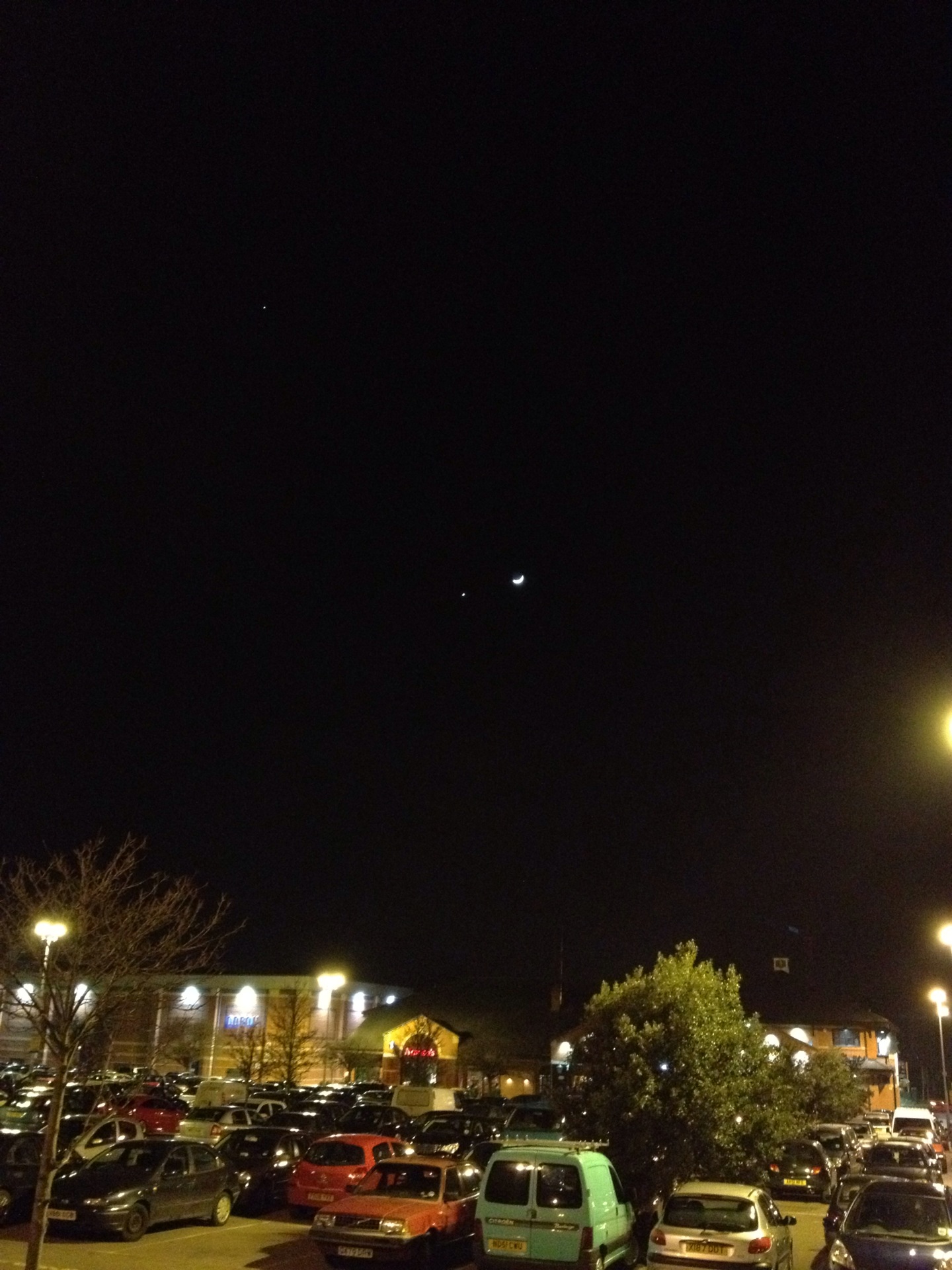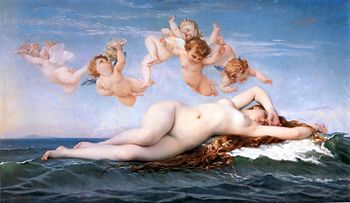"To her who appears in the skyAn ancient Sumerian hymn to Venus, written by priests
to her who appears in the sky
I want to address my greeting
to the hierodule who appears in the sky
I want to address my greeting
to the great queen of heaven, Inanna [ancient Sumerian name for Venus]
I want to address my greeting
to her who fills the sky with her pure blaze
to the luminous one
to Inanna
as bright as the sun
to the great queen of heaven."
[I'd better apologise to the 312 readers who have seen this since I originally posted it last night, as unbeknowst to me only a couple of the images came out. I've tried reuploading them and there's now a couple more of the original ones back.]
The night sky looks amazing at the moment, if you're living in Europe (as some have noticed). For about a week, Jupiter, the moon and Venus have been all clustered together.

(What I would give to live somewhere pictoresque like Bente does, rather than in Leicester city centre!)
It's not often that you look up at the night's sky and can get a feeling for the Earth's place in the solar system. But, with Jupiter and Venus so bright, you can join the dots and see the plane of the solar system, stretching out obliquely in front of you.

I didn't take this one
Venus' relationship with the inhabitants of her neighbour has been divided throughout human history. Some have worshipped it, others have feared it - many have done both.
As an amateur astronomer, I usually like to have a grasp on where the planets are at any one time. I like to be able to glance up and recognize the planets pretty quickly. Even so, sometimes when I'm a bit out of the loop, it's not too difficult to guess where they are. Planets are often a lot less twinkly than stars, and have a dull pin prick like appearance with the naked eye. Mars has a bit of an orangey tint to it, a bit like Betelguese, and Jupiter and Saturn are usually among the brightest things you can see.
But Venus - no, there is no mistaking Venus. Venus is so bright that it really can't be confused with anything, and because you always see it fairly close to the horizon either before or after the sun. It is so bright that it often has a negative magnitude.
Venus has been a witness to all of Earth's history. And likewise, Earth's inhabitants has been a witness to Venus' motions about the solar system - albeit for a much smaller period than Venus has been watching Earth - and this history has been passed down as folklore and mythology.
As such a strange and prominent visitor to our skies, Venus has inspired strong imagery for the peoples of the Earth for millennia. Some have worshipped it, others have feared it - many have done both.
[Basically, I had a fun couple of hours poring through wikipedia and a couple of ebooks, and the following is my exploits before I really had to stop! (It's nice to have an outlet for time wasted). So here we go:]
Our culture inherited Venus from the Romans, who pictured Venus as... well like this.

Many other cultures have this benevolent and beautiful Venus, such as the Norse (Freyja, which gives us Friday), and the Indians (Shukra, pleasure and reproduction). But in the Americas, Venus was revered and feared. The aztecs and mayans were terrified of the planet, as Bernardino de Sahagún, a Franciscan friar noted in the 16th century,
"And when it [Venus] newly emerged, much fear came over them; all were frightened. Everywhere the outlets and openings of [houses] were closed up. It was said that perchance [the light] might bring a cause of sickness, something evil when it came to emerge."Indeed, the Mayans partly based their religious calendar on the motions
 of Venus, and could predict its motions incredibly accurately. They planned for war when Venus was rising.
of Venus, and could predict its motions incredibly accurately. They planned for war when Venus was rising.As a more extreme example, Venus formed a centerpiece to the culture of the Pawnee people of North America, who probably inherited their fear during contact that they had with the Aztecs in the 16th century. Their world was created with the mating of the Morning star (male) and the Evening star (female), both of which we know to be Venus, to produce a girl.
The Pawnee's reverence of the astronomical body culminated in a rather brutal sacrifice, the practice of which ended some time in the early 19th century. To appease the Morning Star, they would sacrifice a 13 year old girl to him, because, by receiving back the first girl to be placed on Earth, the Morning Star would continue to watch over the Pawnees through their endeavors in war and peace.
Here is a brief account of the ceremony, which began in the winter with an vision, and culminated in the winter with a week long ceremony where a kidnapped girl was slaughtered.
Morning star [Venus] appeared as a man anointed with red paint, wrapped around with a buffalo robe, his leggings decorated with scalps and eagle feathers. There were soft down feathers in his hair and a single eagle feather stood upright in his scalplock. Holding his war club, he spoke to the warrior in his dream: "I am the man who has power in the east. I am the Upirikutsu [the Great Star]. You people have forgotten about me. I am watching over your people. Go to the man who knows the ceremony and let him know. He will tell you what to do." [...]The visionary returned to the priest's lodge, where they sat together for 4 days. When he came on the fourth day, the priest took the morning star bundle down from where it was hanging over the sacred altar and removed the holy objects that the warrior would need [...] for his costuming when he impersonated the Morning star so that he could set out on his fateful journey.At the rise of the Morning Star, the leader also danced, put on some of his regalia, and got his pipe ready, and they set out for the enemy village. In his prayer to the Morning Star, he asked that he lose none of his men. [The leader's men] were reminded that they were not to kill unless it was necessary, but only to locate a thirteen year old girl and pronounce her holy for the Great Star.As [the Morning Star party] approached [the home village], the leader set the prarie on fire to let them know that they had been successful. [...]The sacrifice would not take place until the following spring. [The girl] was given a special wooden bowl and a buffalo horn spoon for her exclusive use at meals. It was dangerous for others to use her utensils as the supernatural beings might then consider them part of the sacrifice. [...]One morning, the Morning Star arose ringed in red [I don't know what this represents], giving the signal for the ceremony to begin.[skipping a lot here] The main theme of the fourth day [of the ceremonial period] was the destruction of the four semicardinal circles in the approprate order, as Morning Star [Venus] has done in the creation as he warred on the Evening Star [Venus also]. [...]The girl was taken to the altar to be costumed for her last role. Her body was painted red on the right side (to symbolize day, the time of the Morning Star), black on the left (to represent night, the time of the evening star). They sang to the girl "You are now wearing the covering of meteorite grandfather", and in the next song "You are now wearing the covering of the meteorite father" and then "You are now wearing the covering of the meteorite brother".[...]The four priests came out one by one. The Southest bundle man with the burning stick [representing the sun] ran out of hiding and barely touched the girl on the arms and loins. The Northwest bundle man came out with his bow and arrow and shot her through the heart. Now the Northeast man of the Big Black Meteoric Star rushed up with the flint knife and made a small cut over her heart. Taking some of the blood, he painted streaks on his face. The southwest man came with a warclub and he made a gesture at her. [...] Now all the men and the boys of the Skidi Band, singing war songs, riddled the body with their arrows.[After the sacrifice, they] untied the body and took it about a quarter of a mile to the east, placing it on to the gound face down. They sang, "The whole earth, she shall turn into. The whole earth shall receive her blood". "She will turn into a bunch of grass, the ants will find her, the moths will come and find her, the fox shall come and find her, and last of all will be the bald headed eagle who will come and eat her".In the village, there was general rejoicing.
 Finally, in Australia, Venus was seen as a rather more benevolent - and female - spirit, known as Barnumbirr. She guided the first humans to Australia, and through her, you can contact your ancestors.
Finally, in Australia, Venus was seen as a rather more benevolent - and female - spirit, known as Barnumbirr. She guided the first humans to Australia, and through her, you can contact your ancestors.On Burralku, the island of the dead, spirits gather every evening to dance, sing, and to make a special pole wound in feathered string. Barnumbirr, the Morning Star, is kept in a special dilly bag throughout the day. To the accompaniment of songs, the dancers kick up dust with their feet, blocking out the sun to bring on the dusk and nightfall.
Once the moon has set, just before dawn, a singer calls for Barnumbirr to travel across the sky. An old woman releases the Star tied to feathered string. The Star flies up as the singer chants the names of all the Dhuwa places that it will visit on its westward journey. Just as the sun rises, the old woman pulls on the string and brings Barnumbirr back to Burralku and into the dilly bag for another day.
Anyway, that's the end of that. One final thought, though. It all makes me wonder that, if Venus had inhabitants, who knows the mythology that their peoples would have thought up for us? And what would it be like if we met? Maybe there are two mutually curious planets out there like that somewhere in the galaxy.
I'll post some science some day soon!
Oliver
---
Follow me on Twitter @OliverKnevitt.
By the way, I wanted to have an easier way of finding old articles, so have gone through my back catalogue of articles I've posted here and copied them to a shiny new wordpress blog, which I'll post a link to at some point.





Comments